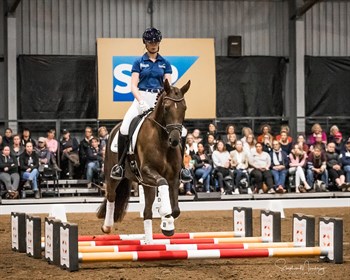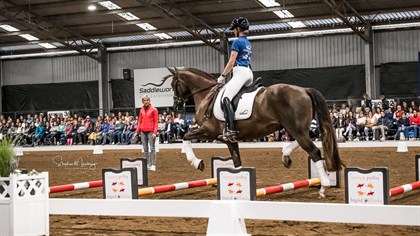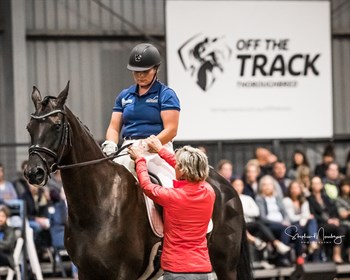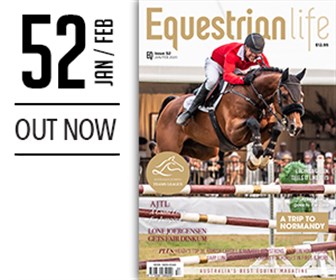
Micky Bray and Ellanbrae Benito Gold over the cavaletti.
© Stephen Mowbray / Dressage Masterclass
By Dr Kerry Mack
The equestrian community have been so excited to welcome Ingrid Klimke to the Dressage Masterclass at Werribee over the weekend. Of course Ingrid is one of the most skilled riders in the world, a multiple gold medalist in eventing who is currently shortlisted to represent equestrian powerhouse Germany for the Tokyo Olympics in both Eventing and Dressage. She is identified with the traditional, classical, approach to horse training as well as being well known for using Cavaletti her training. We have chosen to bring you a series of short articles describing her classes. She started of course with the 4 and 5 year old horses, progressing to the Grand Prix work.
Repetition is the most important tool of training and Ingrid’s classes illustrated the importance of having a system, sticking to the system and carefully repeating the basics. Over the evening each class started with a short warm up (the later classes the horses had mostly warmed up before entering the arena).
Cavaletti were used in the warm up for the young dressage horses. “Start with one cavaletti, use the longest reins possible. Be on the buckle if you can.” A second one was added and then to four cavaletti. “Only use four so that he can jump out if he has to.” The 4-year-old horses walked over a line parallel to the short side, and then trotted over a line on the quarter line. Then the fan-shaped cavaletti on a circle.
Micky Bray and Ellanbrae Benito Gold.
© Stephen Mowbray / Dressage Masterclass
The young mare stumbles and Ingrid reassures the rider, “don’t worry, look, she found a solution,” she says as the horse finds her balance. “More round, turn every step (in the fan) and let her stretch.” The cavaletti encouraged the horses to stretch forward and down into a hand that “softly feels the mouth.” Ingrid was fastidious that the reins were held correctly. Closed fist, thumb like a roof hand vertical, straight line from the elbow to the mouth. The thumb must not be on the top of the whip as this stiffens the hand.
Lillie Connelly and Cilla ride through the cavaletti.
© Stephen Mowbray / Dressage Masterclass
The warm up was followed by a walk break. On the buckle. When the main work started each lesson began with small transitions within the trot and then the bigger transitions. Trot, walk, trot. This was the first real exercise and every horse did this. At first it is done slowly, step-by-step to walk with the young horse and step-by-step to trot. The ears must be the highest point, the focus on the balance “let him grow bigger in front of you”. “Make him more sensitive to the aids, only walk for one step as soon as you feel the walk rhythm, already trot. Active, when you trot out give the rein.” This transition trot, one step of walk, and straight back to an active trot is used as a fundamental tool in each lesson, to make the horse focused and quick off the leg and to improve his balance, more on the hind leg.
Lillie Connelly and Cilla with Ingrid.
© Stephen Mowbray / Dressage Masterclass
Then the 4 year olds did canter, trot, canter transitions. “Canter straight, give the inside rein, be active, feel her swing.” Canter, trot, canter, canter, trot, canter. The young horses have both developed a lovely rhythm and balance through these quick transitions. The lesson ended with an active trot, then when the young mare was really working “allow her to chew the reins.” ‘Chew the reins’ is the English translation of the German “chewing the reins like a cow”, that we call the stretchy circle; allowing the horse to stretch forward and down to finish the lesson with relaxation.
Each lesson follows this template. Warm up, walk, pick up the reins, repeated transitions. All collected work followed by going forwards briskly, then a walk break. The lessons end with forwards, then stretch. As the horse gets more advanced, the work is suitably more complicated, but it is still transitions, collect, go forwards and then stretch.
More next time.
Read Kerry's report from session two here.
Read Kerry's report from session three here.
READ THE LATEST NEWS ARTICLES HERE
https://www.equestrianlife.com.au/articles/Ingrid-Klimke-The-lesson-plan




